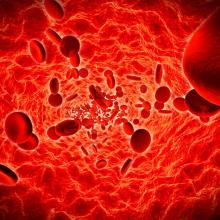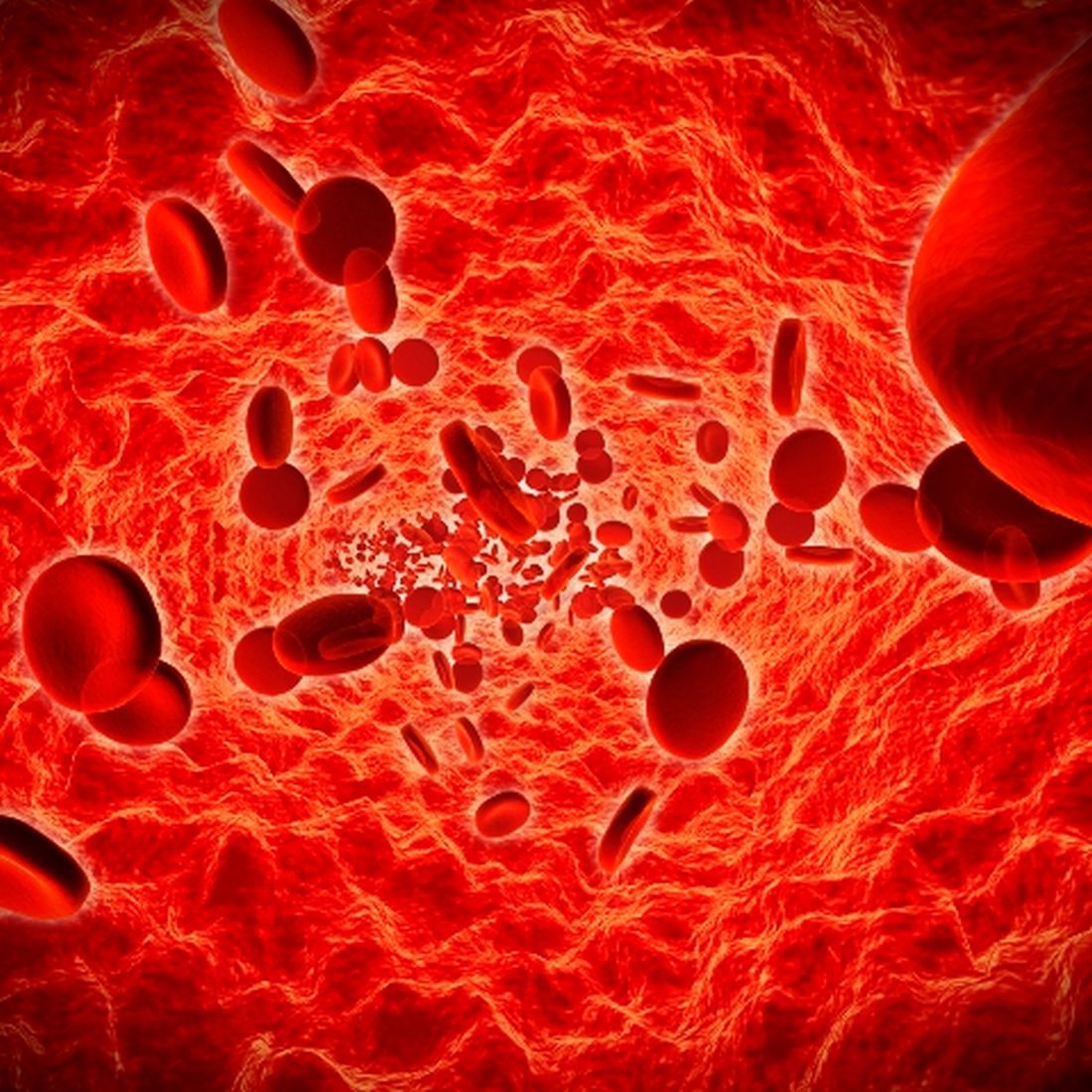User login
By contrast, all-cause mortality was not higher in female transplant recipients who received transfusions from previously pregnant females and was not higher in male or female recipients of transfusions from never-pregnant female donors.
The results need to be replicated in prospective trials. “Further research is needed to replicate these findings, determine their clinical significance, and identify the underlying mechanism,” wrote Camila Caram-Deelder, MSc, of the Center for Clinical Transfusion Research, Sanquin Research, Leiden, the Netherlands, and her coauthors (JAMA. 2017;318[15]:1471-78).
The association “may be related to either immunologic phenomena or other mechanisms,” the investigators said. The cause of increased mortality also could be some difference in iron status between the previously pregnant female donors and male donors.
Ms. Caram-Deelder and her associates studied first-time transfusion recipients treated between 2005 and 2015 at six hospitals in the Netherlands. A total of 42,132 patients received 106,641 units of red blood cells. Among this full cohort, 31,118 patients (52% female) received 59,320 units of red blood cells exclusively from one of the three types of donor (88% male, 6% ever-pregnant female, and 6% never-pregnant female) and were followed up for a median of 245 days. During that time, 13% of the cohort died.
For the 14,995 male recipients in the no-donor-mixture cohort, 13% died during follow-up. The hazard ratio for death after 1 additional unit of red blood cells from a never-pregnant female donor, compared with a unit from a male donor, was 0.93 (95% CI, 0.81 to 1.06) for male recipients and 1.01 (95% CI, 0.88 to 1.15) for female recipients. This difference was not significant. Alternatively, for male recipients the HR for death after 1 additional unit of red blood cells from an ever-pregnant female donor, compared with a unit from a male donor, was 1.13 (95% CI, 1.01 to 1.26). The difference was statistically significant (P = .03).
Of the 16,123 female recipients in the no-donor-mixture cohort, 12% died during follow-up. Mortality rates for an ever-pregnant female donor vs. a male donor were 74 and 62 per 1,000 person-years (HR, 0.99; 95% CI, 0.87 to 1.13); for a never-pregnant female donor vs. a male donor, mortality rates were 74 and 62 per 1,000 person-years (HR, 1.01; 95% CI, 0.88-1.15). The difference was not significant.
The highest HRs for death after transfusion of red blood cells from ever-pregnant female donors were observed in male recipients 50 years and younger.
Study funding came from the Dutch Ministry of Health, Welfare and Sports. One investigator in the study reported receiving a speaking fee from Vifor Pharma and serving on the advisory councils of Novartis and Amgen Science.
The provocative finding that men have an increased mortality risk if they receive red blood cell transplants from women with a history of pregnancy could have significant practical implications if proven true in subsequent studies.
Because of the complex methodology of the study, alternative explanations for the association should be considered.
The differences in mortality seem to increase 1 year or more following the transfusion, suggesting that the trigger may be an immunologic mechanism based on maternal immunization to paternal antigens, but until prospective studies confirm that a donor’s sex and pregnancy status are associated with mortality after transplant, “appropriate and conservative use of blood products continues to be the gold standard for safe transfusion.”
Ritchard G. Cable, MD, is with American Red Cross Blood Services, Connecticut Region, Farmington. Gustaf Edgren, MD, PhD, is with the department of hematology at Karolinska University Hospital, Stockholm. These comments are based on their accompanying editorial (JAMA. 2017 Oct 17;318[15]:1445-7). They reported no financial conflicts of interest.
The provocative finding that men have an increased mortality risk if they receive red blood cell transplants from women with a history of pregnancy could have significant practical implications if proven true in subsequent studies.
Because of the complex methodology of the study, alternative explanations for the association should be considered.
The differences in mortality seem to increase 1 year or more following the transfusion, suggesting that the trigger may be an immunologic mechanism based on maternal immunization to paternal antigens, but until prospective studies confirm that a donor’s sex and pregnancy status are associated with mortality after transplant, “appropriate and conservative use of blood products continues to be the gold standard for safe transfusion.”
Ritchard G. Cable, MD, is with American Red Cross Blood Services, Connecticut Region, Farmington. Gustaf Edgren, MD, PhD, is with the department of hematology at Karolinska University Hospital, Stockholm. These comments are based on their accompanying editorial (JAMA. 2017 Oct 17;318[15]:1445-7). They reported no financial conflicts of interest.
The provocative finding that men have an increased mortality risk if they receive red blood cell transplants from women with a history of pregnancy could have significant practical implications if proven true in subsequent studies.
Because of the complex methodology of the study, alternative explanations for the association should be considered.
The differences in mortality seem to increase 1 year or more following the transfusion, suggesting that the trigger may be an immunologic mechanism based on maternal immunization to paternal antigens, but until prospective studies confirm that a donor’s sex and pregnancy status are associated with mortality after transplant, “appropriate and conservative use of blood products continues to be the gold standard for safe transfusion.”
Ritchard G. Cable, MD, is with American Red Cross Blood Services, Connecticut Region, Farmington. Gustaf Edgren, MD, PhD, is with the department of hematology at Karolinska University Hospital, Stockholm. These comments are based on their accompanying editorial (JAMA. 2017 Oct 17;318[15]:1445-7). They reported no financial conflicts of interest.
By contrast, all-cause mortality was not higher in female transplant recipients who received transfusions from previously pregnant females and was not higher in male or female recipients of transfusions from never-pregnant female donors.
The results need to be replicated in prospective trials. “Further research is needed to replicate these findings, determine their clinical significance, and identify the underlying mechanism,” wrote Camila Caram-Deelder, MSc, of the Center for Clinical Transfusion Research, Sanquin Research, Leiden, the Netherlands, and her coauthors (JAMA. 2017;318[15]:1471-78).
The association “may be related to either immunologic phenomena or other mechanisms,” the investigators said. The cause of increased mortality also could be some difference in iron status between the previously pregnant female donors and male donors.
Ms. Caram-Deelder and her associates studied first-time transfusion recipients treated between 2005 and 2015 at six hospitals in the Netherlands. A total of 42,132 patients received 106,641 units of red blood cells. Among this full cohort, 31,118 patients (52% female) received 59,320 units of red blood cells exclusively from one of the three types of donor (88% male, 6% ever-pregnant female, and 6% never-pregnant female) and were followed up for a median of 245 days. During that time, 13% of the cohort died.
For the 14,995 male recipients in the no-donor-mixture cohort, 13% died during follow-up. The hazard ratio for death after 1 additional unit of red blood cells from a never-pregnant female donor, compared with a unit from a male donor, was 0.93 (95% CI, 0.81 to 1.06) for male recipients and 1.01 (95% CI, 0.88 to 1.15) for female recipients. This difference was not significant. Alternatively, for male recipients the HR for death after 1 additional unit of red blood cells from an ever-pregnant female donor, compared with a unit from a male donor, was 1.13 (95% CI, 1.01 to 1.26). The difference was statistically significant (P = .03).
Of the 16,123 female recipients in the no-donor-mixture cohort, 12% died during follow-up. Mortality rates for an ever-pregnant female donor vs. a male donor were 74 and 62 per 1,000 person-years (HR, 0.99; 95% CI, 0.87 to 1.13); for a never-pregnant female donor vs. a male donor, mortality rates were 74 and 62 per 1,000 person-years (HR, 1.01; 95% CI, 0.88-1.15). The difference was not significant.
The highest HRs for death after transfusion of red blood cells from ever-pregnant female donors were observed in male recipients 50 years and younger.
Study funding came from the Dutch Ministry of Health, Welfare and Sports. One investigator in the study reported receiving a speaking fee from Vifor Pharma and serving on the advisory councils of Novartis and Amgen Science.
By contrast, all-cause mortality was not higher in female transplant recipients who received transfusions from previously pregnant females and was not higher in male or female recipients of transfusions from never-pregnant female donors.
The results need to be replicated in prospective trials. “Further research is needed to replicate these findings, determine their clinical significance, and identify the underlying mechanism,” wrote Camila Caram-Deelder, MSc, of the Center for Clinical Transfusion Research, Sanquin Research, Leiden, the Netherlands, and her coauthors (JAMA. 2017;318[15]:1471-78).
The association “may be related to either immunologic phenomena or other mechanisms,” the investigators said. The cause of increased mortality also could be some difference in iron status between the previously pregnant female donors and male donors.
Ms. Caram-Deelder and her associates studied first-time transfusion recipients treated between 2005 and 2015 at six hospitals in the Netherlands. A total of 42,132 patients received 106,641 units of red blood cells. Among this full cohort, 31,118 patients (52% female) received 59,320 units of red blood cells exclusively from one of the three types of donor (88% male, 6% ever-pregnant female, and 6% never-pregnant female) and were followed up for a median of 245 days. During that time, 13% of the cohort died.
For the 14,995 male recipients in the no-donor-mixture cohort, 13% died during follow-up. The hazard ratio for death after 1 additional unit of red blood cells from a never-pregnant female donor, compared with a unit from a male donor, was 0.93 (95% CI, 0.81 to 1.06) for male recipients and 1.01 (95% CI, 0.88 to 1.15) for female recipients. This difference was not significant. Alternatively, for male recipients the HR for death after 1 additional unit of red blood cells from an ever-pregnant female donor, compared with a unit from a male donor, was 1.13 (95% CI, 1.01 to 1.26). The difference was statistically significant (P = .03).
Of the 16,123 female recipients in the no-donor-mixture cohort, 12% died during follow-up. Mortality rates for an ever-pregnant female donor vs. a male donor were 74 and 62 per 1,000 person-years (HR, 0.99; 95% CI, 0.87 to 1.13); for a never-pregnant female donor vs. a male donor, mortality rates were 74 and 62 per 1,000 person-years (HR, 1.01; 95% CI, 0.88-1.15). The difference was not significant.
The highest HRs for death after transfusion of red blood cells from ever-pregnant female donors were observed in male recipients 50 years and younger.
Study funding came from the Dutch Ministry of Health, Welfare and Sports. One investigator in the study reported receiving a speaking fee from Vifor Pharma and serving on the advisory councils of Novartis and Amgen Science.
FROM JAMA
Key clinical point: Receiving a red blood cell transfusion from a female donor with any history of pregnancy was associated with increased mortality in men, but not in women.
Major finding: Among men, all-cause mortality after transfusion from an ever-pregnant female donor vs. a male donor was 101 vs. 80 deaths per 1000 person-years (hazard ratio, 1.13; 95% confidence interval, 1.01-1.26).
Data source: Retrospective cohort study of 31,118 patients who received red blood cell transfusions exclusively from one of the three types of donor – 88% male, 6% ever-pregnant female, and 6% never-pregnant female – at one of six Dutch hospitals.
Disclosures: Study funding came from the Dutch Ministry of Health, Welfare and Sports. One investigator in the study reported receiving a speaking fee from Vifor Pharma and serving on the advisory councils of Novartis and Amgen Science.

